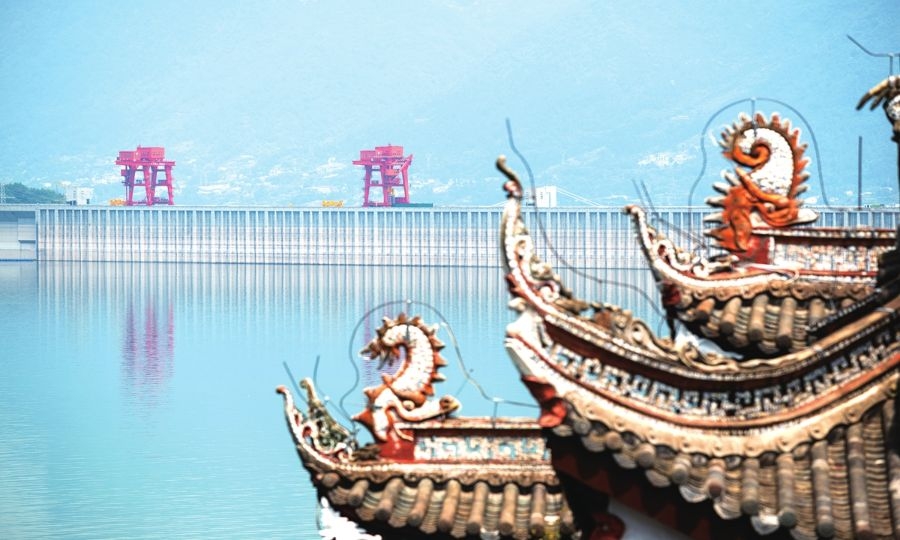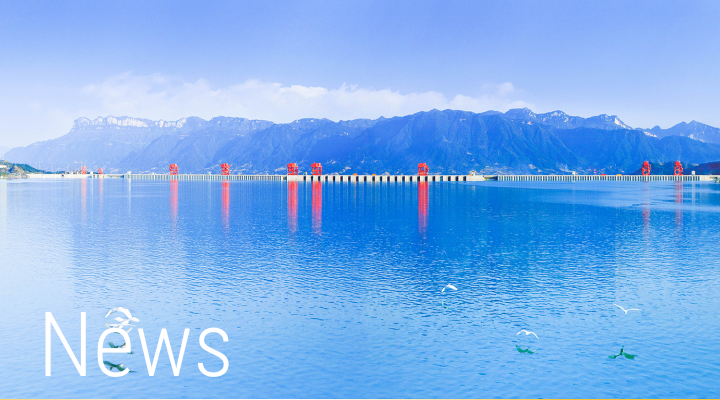Three Gorges Dam: a model of China’s infrastructure construction featuring smarter, greener and more creative
From:
Date: 2024-07-26

The Three Gorges Dam in Yichang, Central China's Hubei Province on May 22, 2024 Photo: Chen Tao/GT
Editor's Note:?As the Chinese economy has faced challenges in recent years, some Western officials and media pundits have stepped up their smear campaign against China. They cherry-pick information and distort facts to hype their narratives such as "Peak China," but they always turn a blind eye to China's economic resilience and development potential. In order to set the record straight, the Global Times is launching a multimedia project, including in-depth articles, objective analysis and visual arts, to present a comprehensive and true picture of the economy. This is the 11th installation of the series.
Since the start of the construction of the Three Gorges Dam, China's hydropower ecosystem has overcome difficulties and realized the independent design and manufacturing of hydropower equipment and the localization of important materials.?
The Global Times recently made a visit to the Gezhouba Dam and the Three Gorges Dam to discover how China's infrastructure construction, taking the building of hydropower stations as example, started from scratch to become a global leader, and how infrastructure construction becomes smarter, greener and more creative.
The Gezhouba Hydropower Station, located in Yichang, Central China's Hubei Province, was the first large-scale water control project on the main artery of the Yangtze River and was a milestone of China's hydropower generation. The first group of generator units was commissioned in 1981, with the hydropower station already being operational for more than 40 years safely.
In 2003, the first batch of electricity generator units of the Three Gorges Hydroelectric Power Station, commonly known as the Three Gorges Dam, entered service. The Three Gorges project, which started construction in 1994 based on experience from the construction of the Gezhouba station, remains as the world's largest hydroelectric power plant in terms of installed capacity.
Hard-won achievements
In the design and manufacture of the power station units for the Three Gorges Dam, domestic manufacturers have continuously promoted independent innovation and mastered the key and core technologies of the manufacture of the hydro-generator set, an industry insider told the Global Times.
"The construction of the Three Gorges Dam has laid the foundation for localization of hydropower station buildings in China," the insider said.
The six mega hydropower stations along the upper and middle reaches of the Yangtze River - The Three Gorges, Wudongde, Baihetan, Xiluodu, Xiangjiaba, and Gezhouba - form the world's largest clean energy corridor, which spans over 1,800 kilometers with a water level drop exceeding 900 meters.?
The construction of the corridor has taken nearly half a century, and was completed in December 2022, when the Baihetan Hydropower Station, located in the upper reaches of the Yangtze River - the lower reaches of the Jinsha River - in Southwest China, became fully operational.
The corridor, an enormous project, has become the best in class globally for many aspects of its construction and operation, such as being the world's thinnest 300-meter-level ultra-high arch dam, the world's highest underground powerhouse, and the world's largest single unit of power generator in terms of capacity.
Domestically-driven innovation
After the completion of the Three Gorges Dam project, China started the development and construction of cascade hydropower stations in upper reaches of the Yangtze River.
Domestic enterprises for hydropower equipment design and manufacturing have continuously set new records in the field of major hydropower technical equipment.
On June 28, 2021, the first generation of hydro-generator units with a capacity of 1 million kilowatts at the Baihetan Hydropower Station successfully entered operation, achieving breakthroughs in leading the world's hydropower development.
Behind the improvement of unit capacity is the comprehensive research and development and application of new materials, new processes, new equipment and new technologies.
China's hydropower ecosystem has realized independent design, manufacturing, and localization of key raw materials. Some technologies have filled the gaps in related fields at home and abroad, meaning that transformation from "made in China" to "created in China" has been achieved, enabling China's hydropower equipment manufacturing remaining at world's leading position, industry insiders told the Global Times.
They also noted that the construction of the Three Gorges Dam represents the epitome of China's infrastructure building and the transformation in its manufacturing industry.
So far, a total of 110 hydroelectric generators are operational in the world's largest clean energy corridor. The total installed capacity of the six hydropower stations has already hit 71.695 million kilowatts, producing about 300 billion kilowatt-hours of clean electricity annually, which can meet the annual electricity demand for roughly 360 million people, the Global Times was told.?
While the installed capacity of domestic power generation units is increasing, the construction of China's dams has also entered an intelligent era. Based on the Three Gorges Dam, Wudongde and Baihetan hydropower stations have further advanced the intelligent construction, providing a "Three Gorges model" for the digitalization and intelligence of the infrastructure construction industry.
Digitalized operation
Apart from smart construction, China's traditional energy industry has embarked on a digital transformation in operation and maintenance in recent years.
Despite its immensity, the operations of the Three Gorges Dam have been simple and easy, streamlined through a digitalization process. Technicians only need to use mobile phones or tablets to complete various tasks, including equipment maintenance management, operation scheduling management, safety and reliability monitoring, and document management.
"We use the water telemetry system, the decision-making system of comprehensive utilization of water resources and the data model to effectively release the comprehensive potential of cascade hydropower stations, such as flood control, navigation, water replenishment, ecology and power generation," an insider from a digital control center, which acts as the brain of the world's largest clean energy corridor, under the China Three Gorges Corporation (CTG), told the Global Times.
On the large screens at the control center, located in Yichang, the Global Times observed that the water and rain conditions in the Yangtze River basin and real-time production information of six cascade power stations in the Yangtze River main stream are accurately presented.?
By April 2024, the industrial internet platform has been deployed in all six cascaded hydropower stations along the mainstem of the Yangtze River, the Global Times learned from CTG.
After the application of the industrial internet platform in the Yangtze River basin hydropower stations, the comprehensive utilization rate of water resources, the operation efficiency of the power stations, and the operation safety and reliability will be further improved, a vivid example of "5G+ Industrial Internet" enabling new industrialization, said China Yangtze Power Co (CYPC), a subsidiary of CTG and the constructor of the industrial internet platform.
CYPC has independently developed the industrial internet platform for the cascade hydropower stations to enable intelligent operation, maintenance, scheduling, decision-making, and other scenarios, the Global Times learned.
The collaborative operation and coordination of six cascade hydropower stations is a world-class challenge. It is necessary to rely on advanced technologies such as artificial intelligence and big data models to build an industrial internet platform, a director at a research center of CYPC, told the Global Times.
?
All Copyrigh
By China Three Gorges Corporation
Reprinting or mirroring is strictly prohibited without written authorization,
and offenders will be held liable.















